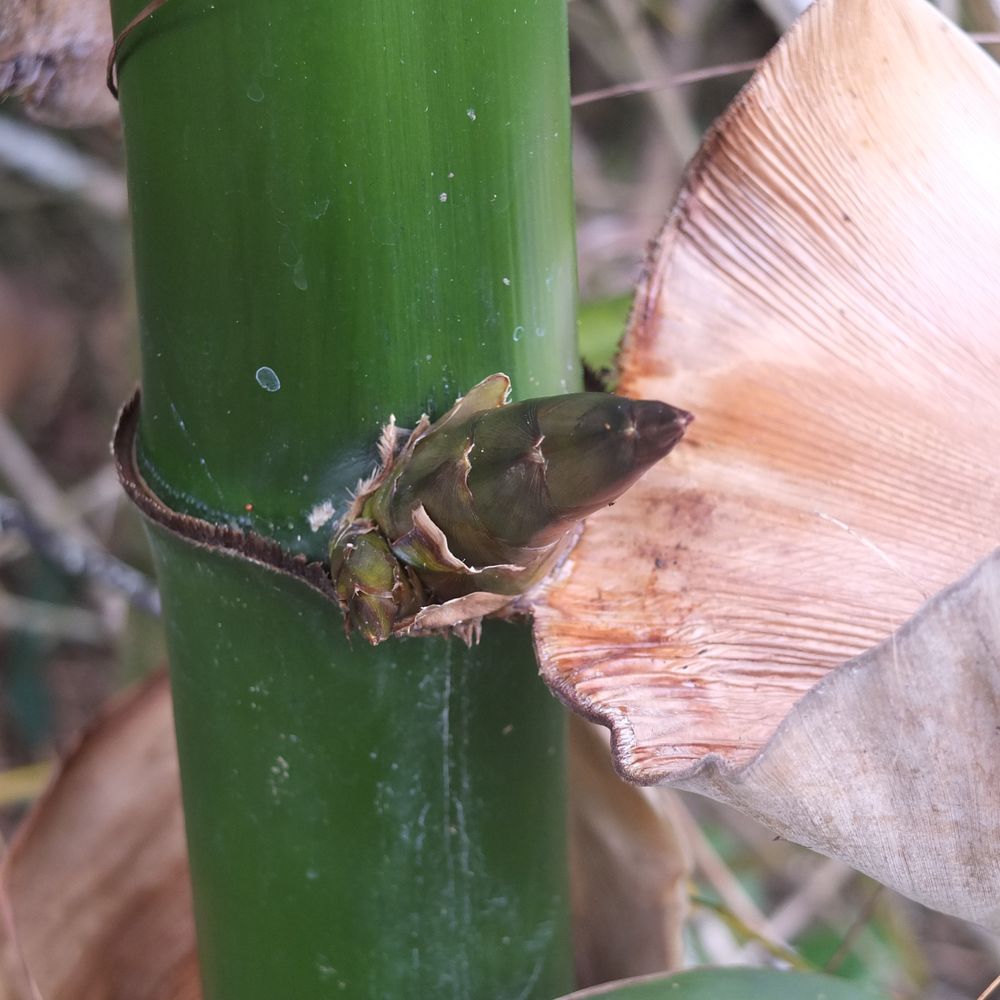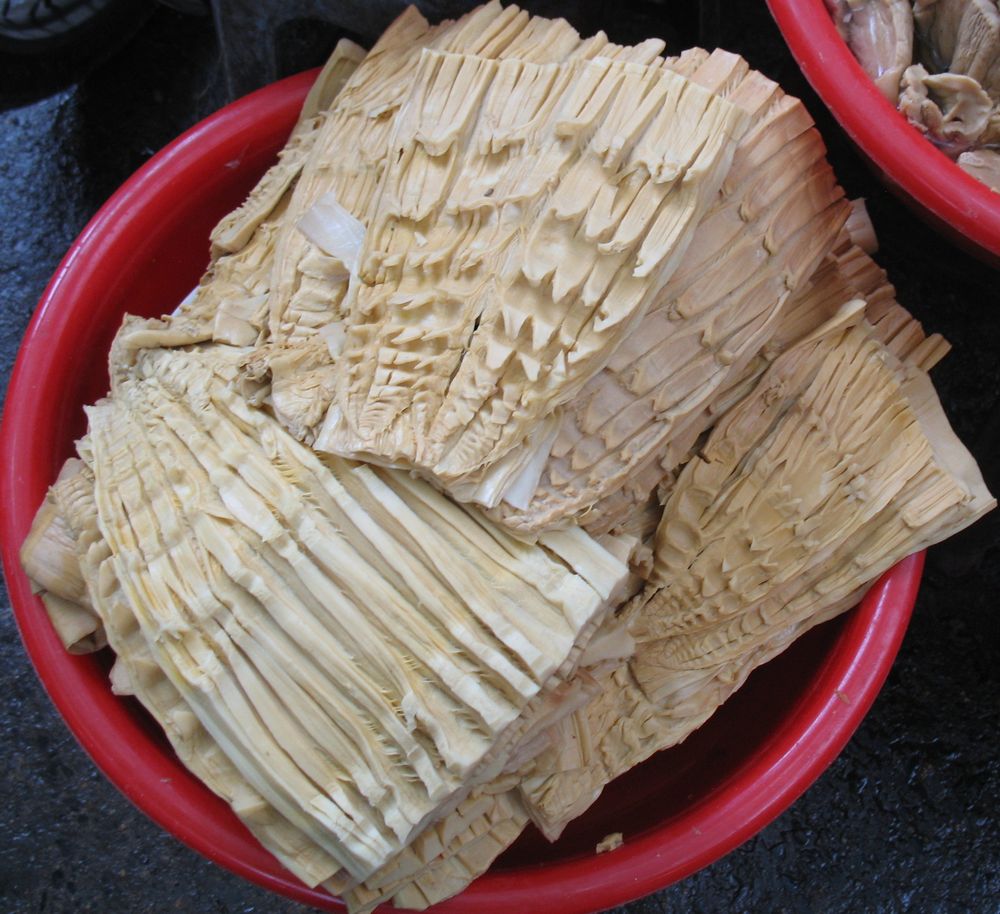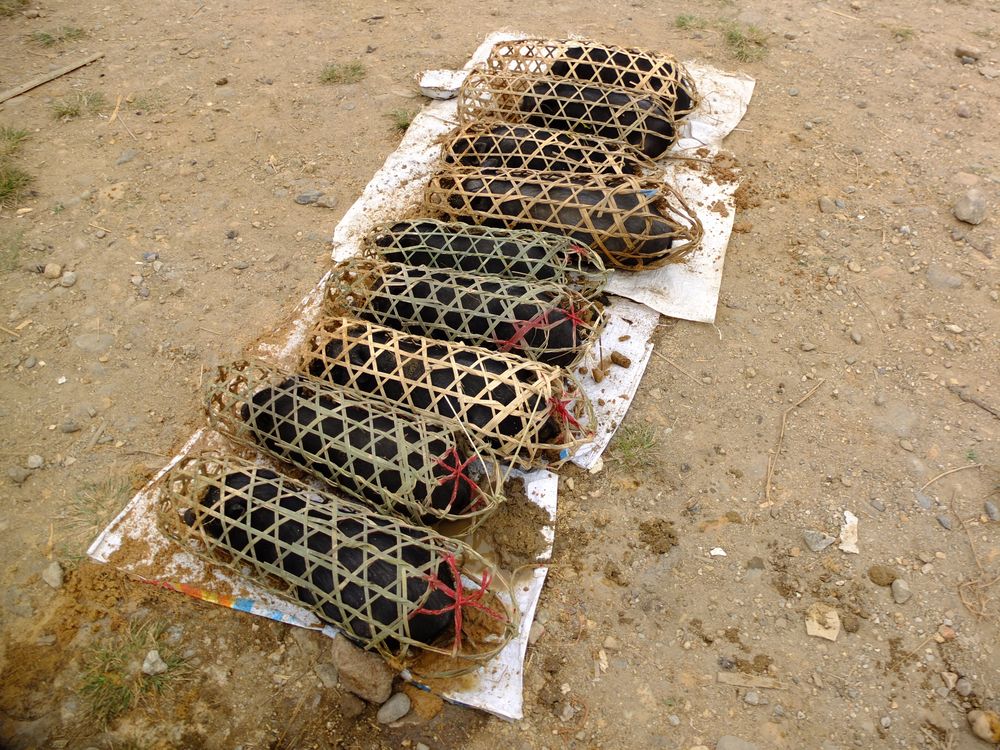Everyone knows Bamboo, especially in Laos, but behind this simple name hides a very complex botanical reality. In fact, Bamboo, which is a “reed tree”, does not resemble any other plant.
All Bamboos have underground stems called rhizomes from which roots emerge and also buds which will give either another rhizome or a shoot and an aerial stem, generally hollow, called thatch. This thatch is partitioned at the level of the nodes on which the sheath which protects the young shoot and then the stem is inserted; this sheath is important to determine the species of Bamboo which cannot be made from the flowers. Indeed, the flowering of Bamboos presents particularities which are yet neither completely verified nor completely explained; it is not regular and often spaced several decades apart; for a given species, it occurs simultaneously throughout an entire region, or even the entire world, regardless of the age of the plant; and finally the Bamboos dry out and die after flowering.
In the 18th century the genus Bambusa was created, but over the next two centuries botanists had to create 75 new genera to account for the diversity of Bamboos. Most Bamboos are Asian, others American and a few African. The Lao, like their neighbors, use around twenty species which correspond to around fifty Lao vernacular names. It is therefore impossible to give an account here of all the names and uses which, “from the cradle to the grave”, accompany the life of the Lao. Here for example mai khom:
Indosasa sinica C.D.Chu.&C.S.Chao, the shoots of this Bamboo are highly sought after and even exported; they are not bitter, despite their name, (khom means “bitter”) but rather sweet. The thatch is 7 to 12 m. The flowering of this Bamboo is unknown but the shoots emerge from December to May in large numbers in the hills and low reliefs of northern and middle Laos. Their turgor emerging from the ground is spectacular, the beauty of their colors and the power of their erection are impressive.
Although, in theory, the shoots of all Bamboo are
edible, some contain toxins which will be eliminated by cooking; the non-connoisseur therefore has an interest in always boiling them. The general rule is to wash them, remove a first covering, put them in boiling water for a long time then remove a final protective layer before cooking them. Just cooked, they can be eaten with a spicy sauce or shrimp sauce; cut into long strips they will be put in salad; they can be fried with meat and other vegetables; they are also very popular in soups and especially in the famous kèng no mai whose green color and slightly gelatinous texture are due to ya nang (Tiliacora triandra).
Tout le monde connaît le bambou, surtout au Laos, mais derrière ce nom simple se cache une réalité botanique très complexe. En effet le bambou qui est un « arbre–roseau » ne ressemble à aucune autre plante.
Tous les bambous ont des tiges souterraines appelées rhizomes d’où partent des racines et aussi des bourgeons qui donneront soit un autre rhizome, soit une pousse et une tige aérienne, généralement creuse, appelée chaume. Ce chaume est cloisonné au niveau des nœuds sur lesquels s’insère la gaine qui protège la jeune pousse puis la tige; cette gaine est importante pour déterminer l’espèce du bambou qui ne peut se faire à partir des fleurs. En effet la floraison des bambous présente des particularités qui ne sont encore ni complétement vérifiées ni complétement expliquées; elle n’est pas régulière et souvent espacée de plusieurs dizaines d’années; pour une espèce donnée, elle se produit simultanément dans toute une région, voire dans le monde entier, quel que soit l’âge de la plante; et enfin les bambous se dessèchent et meurent après avoir fleuri.
Au XVIIIème siècle fut créé le genre Bambusa, mais pendant les deux siècles suivants les botanistes ont dû créer 75 genres nouveaux pour rendre compte de la diversité des bambous. La plupart des bambous sont asiatiques, d’autres américains et quelques-uns africains. Les Lao, comme leurs voisins, en utilisent environ une vingtaine d’espèces qui correspondent à une cinquantaine de noms vernaculaires lao. Il est donc impossible de rendre compte ici de tous les noms et de tous les usages qui, « du berceau au tombeau », accompagnent la vie des Lao. Voici par exemple mai khom :
Indosasa sinica C.D.Chu.&C.S.Chao, les pousses de ce bambou sont très recherchées et même exportées; elles ne sont pas amères, malgré leur nom, (khom veut dire « amer ») mais plutôt sucrées. Le chaume a de7 à 12 m. La floraison de ce bambou est inconnue mais les pousses sortent de décembre à mai en grand nombre dans les collines et les reliefs peu élevés du nord et moyen Laos. Leur turgescence émergeant du sol est spectaculaire, la beauté de leurs couleurs et la puissance de leur érection impressionnent.
Si, en théorie, les pousses de tous les bambous sont comestibles, certaines contiennent des toxines qui seront éliminées par la cuisson; le non-connaisseur a donc intérêt à toujours les faire bouillir. La règle générale consiste à les laver, à retirer une première enveloppe, à les mettre assez longtemps à l’eau bouillante puis à enlever une dernière couche protectrice avant de les cuisiner. Juste cuites, elles pourront être mangées avec une sauce piquante ou une sauce à la crevette; découpées en longues lamelles elles seront mises en salade; elles peuvent être fricassées avec viande et autres légumes; elles sont aussi très appréciées en soupe et surtout dans la fameuse kèng no mai dont la couleur verte et la texture un peu gélatineuse sont dues à ya nang (Tiliacora triandra).





Everyone knows Bamboo, especially in Laos, but behind this simple name hides a very complex botanical reality. In fact, Bamboo, which is a “reed tree”, does not resemble any other plant.
All Bamboos have underground stems called rhizomes from which roots emerge and also buds which will give either another rhizome or a shoot and an aerial stem, generally hollow, called thatch. This thatch is partitioned at the level of the nodes on which the sheath which protects the young shoot and then the stem is inserted; this sheath is important to determine the species of Bamboo which cannot be made from the flowers. Indeed, the flowering of Bamboos presents particularities which are yet neither completely verified nor completely explained; it is not regular and often spaced several decades apart; for a given species, it occurs simultaneously throughout an entire region, or even the entire world, regardless of the age of the plant; and finally the Bamboos dry out and die after flowering.
In the 18th century the genus Bambusa was created, but over the next two centuries botanists had to create 75 new genera to account for the diversity of Bamboos. Most Bamboos are Asian, others American and a few African. The Lao, like their neighbors, use around twenty species which correspond to around fifty Lao vernacular names. It is therefore impossible to give an account here of all the names and uses which, “from the cradle to the grave”, accompany the life of the Lao. Here for example mai khom:
Indosasa sinica C.D.Chu.&C.S.Chao, the shoots of this Bamboo are highly sought after and even exported; they are not bitter, despite their name, (khom means “bitter”) but rather sweet. The thatch is 7 to 12 m. The flowering of this Bamboo is unknown but the shoots emerge from December to May in large numbers in the hills and low reliefs of northern and middle Laos. Their turgor emerging from the ground is spectacular, the beauty of their colors and the power of their erection are impressive.
Although, in theory, the shoots of all Bamboo are
edible, some contain toxins which will be eliminated by cooking; the non-connoisseur therefore has an interest in always boiling them. The general rule is to wash them, remove a first covering, put them in boiling water for a long time then remove a final protective layer before cooking them. Just cooked, they can be eaten with a spicy sauce or shrimp sauce; cut into long strips they will be put in salad; they can be fried with meat and other vegetables; they are also very popular in soups and especially in the famous kèng no mai whose green color and slightly gelatinous texture are due to ya nang (Tiliacora triandra).
Tout le monde connaît le bambou, surtout au Laos, mais derrière ce nom simple se cache une réalité botanique très complexe. En effet le bambou qui est un « arbre–roseau » ne ressemble à aucune autre plante.
Tous les bambous ont des tiges souterraines appelées rhizomes d’où partent des racines et aussi des bourgeons qui donneront soit un autre rhizome, soit une pousse et une tige aérienne, généralement creuse, appelée chaume. Ce chaume est cloisonné au niveau des nœuds sur lesquels s’insère la gaine qui protège la jeune pousse puis la tige; cette gaine est importante pour déterminer l’espèce du bambou qui ne peut se faire à partir des fleurs. En effet la floraison des bambous présente des particularités qui ne sont encore ni complétement vérifiées ni complétement expliquées; elle n’est pas régulière et souvent espacée de plusieurs dizaines d’années; pour une espèce donnée, elle se produit simultanément dans toute une région, voire dans le monde entier, quel que soit l’âge de la plante; et enfin les bambous se dessèchent et meurent après avoir fleuri.
Au XVIIIème siècle fut créé le genre Bambusa, mais pendant les deux siècles suivants les botanistes ont dû créer 75 genres nouveaux pour rendre compte de la diversité des bambous. La plupart des bambous sont asiatiques, d’autres américains et quelques-uns africains. Les Lao, comme leurs voisins, en utilisent environ une vingtaine d’espèces qui correspondent à une cinquantaine de noms vernaculaires lao. Il est donc impossible de rendre compte ici de tous les noms et de tous les usages qui, « du berceau au tombeau », accompagnent la vie des Lao. Voici par exemple mai khom :
Indosasa sinica C.D.Chu.&C.S.Chao, les pousses de ce bambou sont très recherchées et même exportées; elles ne sont pas amères, malgré leur nom, (khom veut dire « amer ») mais plutôt sucrées. Le chaume a de7 à 12 m. La floraison de ce bambou est inconnue mais les pousses sortent de décembre à mai en grand nombre dans les collines et les reliefs peu élevés du nord et moyen Laos. Leur turgescence émergeant du sol est spectaculaire, la beauté de leurs couleurs et la puissance de leur érection impressionnent.
Si, en théorie, les pousses de tous les bambous sont comestibles, certaines contiennent des toxines qui seront éliminées par la cuisson; le non-connaisseur a donc intérêt à toujours les faire bouillir. La règle générale consiste à les laver, à retirer une première enveloppe, à les mettre assez longtemps à l’eau bouillante puis à enlever une dernière couche protectrice avant de les cuisiner. Juste cuites, elles pourront être mangées avec une sauce piquante ou une sauce à la crevette; découpées en longues lamelles elles seront mises en salade; elles peuvent être fricassées avec viande et autres légumes; elles sont aussi très appréciées en soupe et surtout dans la fameuse kèng no mai dont la couleur verte et la texture un peu gélatineuse sont dues à ya nang (Tiliacora triandra).










Everyone knows Bamboo, especially in Laos, but behind this simple name hides a very complex botanical reality. In fact, Bamboo, which is a “reed tree”, does not resemble any other plant.
All Bamboos have underground stems called rhizomes from which roots emerge and also buds which will give either another rhizome or a shoot and an aerial stem, generally hollow, called thatch. This thatch is partitioned at the level of the nodes on which the sheath which protects the young shoot and then the stem is inserted; this sheath is important to determine the species of Bamboo which cannot be made from the flowers. Indeed, the flowering of Bamboos presents particularities which are yet neither completely verified nor completely explained; it is not regular and often spaced several decades apart; for a given species, it occurs simultaneously throughout an entire region, or even the entire world, regardless of the age of the plant; and finally the Bamboos dry out and die after flowering.
In the 18th century the genus Bambusa was created, but over the next two centuries botanists had to create 75 new genera to account for the diversity of Bamboos. Most Bamboos are Asian, others American and a few African. The Lao, like their neighbors, use around twenty species which correspond to around fifty Lao vernacular names. It is therefore impossible to give an account here of all the names and uses which, “from the cradle to the grave”, accompany the life of the Lao. Here for example mai khom:
Indosasa sinica C.D.Chu.&C.S.Chao, the shoots of this Bamboo are highly sought after and even exported; they are not bitter, despite their name, (khom means “bitter”) but rather sweet. The thatch is 7 to 12 m. The flowering of this Bamboo is unknown but the shoots emerge from December to May in large numbers in the hills and low reliefs of northern and middle Laos. Their turgor emerging from the ground is spectacular, the beauty of their colors and the power of their erection are impressive.
Although, in theory, the shoots of all Bamboo are
edible, some contain toxins which will be eliminated by cooking; the non-connoisseur therefore has an interest in always boiling them. The general rule is to wash them, remove a first covering, put them in boiling water for a long time then remove a final protective layer before cooking them. Just cooked, they can be eaten with a spicy sauce or shrimp sauce; cut into long strips they will be put in salad; they can be fried with meat and other vegetables; they are also very popular in soups and especially in the famous kèng no mai whose green color and slightly gelatinous texture are due to ya nang (Tiliacora triandra).
Tout le monde connaît le bambou, surtout au Laos, mais derrière ce nom simple se cache une réalité botanique très complexe. En effet le bambou qui est un « arbre–roseau » ne ressemble à aucune autre plante.
Tous les bambous ont des tiges souterraines appelées rhizomes d’où partent des racines et aussi des bourgeons qui donneront soit un autre rhizome, soit une pousse et une tige aérienne, généralement creuse, appelée chaume. Ce chaume est cloisonné au niveau des nœuds sur lesquels s’insère la gaine qui protège la jeune pousse puis la tige; cette gaine est importante pour déterminer l’espèce du bambou qui ne peut se faire à partir des fleurs. En effet la floraison des bambous présente des particularités qui ne sont encore ni complétement vérifiées ni complétement expliquées; elle n’est pas régulière et souvent espacée de plusieurs dizaines d’années; pour une espèce donnée, elle se produit simultanément dans toute une région, voire dans le monde entier, quel que soit l’âge de la plante; et enfin les bambous se dessèchent et meurent après avoir fleuri.
Au XVIIIème siècle fut créé le genre Bambusa, mais pendant les deux siècles suivants les botanistes ont dû créer 75 genres nouveaux pour rendre compte de la diversité des bambous. La plupart des bambous sont asiatiques, d’autres américains et quelques-uns africains. Les Lao, comme leurs voisins, en utilisent environ une vingtaine d’espèces qui correspondent à une cinquantaine de noms vernaculaires lao. Il est donc impossible de rendre compte ici de tous les noms et de tous les usages qui, « du berceau au tombeau », accompagnent la vie des Lao. Voici par exemple mai khom :
Indosasa sinica C.D.Chu.&C.S.Chao, les pousses de ce bambou sont très recherchées et même exportées; elles ne sont pas amères, malgré leur nom, (khom veut dire « amer ») mais plutôt sucrées. Le chaume a de7 à 12 m. La floraison de ce bambou est inconnue mais les pousses sortent de décembre à mai en grand nombre dans les collines et les reliefs peu élevés du nord et moyen Laos. Leur turgescence émergeant du sol est spectaculaire, la beauté de leurs couleurs et la puissance de leur érection impressionnent.
Si, en théorie, les pousses de tous les bambous sont comestibles, certaines contiennent des toxines qui seront éliminées par la cuisson; le non-connaisseur a donc intérêt à toujours les faire bouillir. La règle générale consiste à les laver, à retirer une première enveloppe, à les mettre assez longtemps à l’eau bouillante puis à enlever une dernière couche protectrice avant de les cuisiner. Juste cuites, elles pourront être mangées avec une sauce piquante ou une sauce à la crevette; découpées en longues lamelles elles seront mises en salade; elles peuvent être fricassées avec viande et autres légumes; elles sont aussi très appréciées en soupe et surtout dans la fameuse kèng no mai dont la couleur verte et la texture un peu gélatineuse sont dues à ya nang (Tiliacora triandra).


